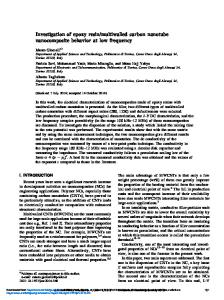Temperature dependence of single-walled carbon nanotube migration in epoxy resin under DC electric field
- PDF / 2,871,133 Bytes
- 14 Pages / 595.276 x 790.866 pts Page_size
- 21 Downloads / 287 Views
Temperature dependence of single-walled carbon nanotube migration in epoxy resin under DC electric field Dandan Zhang1,2
, Connor Saukas2, Yipeng He2, Rumin Wang1, and Alan I. Taub2,*
1
Department of Applied Chemistry, School of Natural and Applied Sciences, Northwestern Polytechnical University, Xi’an 710072, Shaanxi, People’s Republic of China 2 Department of Materials Science and Engineering & Mechanical Engineering, University of Michigan, Ann Arbor, MI 48109, USA
Received: 27 May 2020
ABSTRACT
Accepted: 21 August 2020
Electric fields have been shown to induce orientation of CNTs in a polymer matrix along the direction of the applied field. When using a DC field, the CNTs also migrate between the two electrodes, resulting in a nonuniform CNT concentration across the composite sample and impacting the strengthening effect gained from the CNT alignment. In this study, we applied a DC electric field to a single-walled carbon nanotube (SWCNT)/epoxy solution and investigated the migration kinetics at different temperatures (34.0–56.6 °C) by tracking the realtime changes of SWCNT concentration. The SWCNTs were found to migrate from the negative electrode to the positive electrode at a constant speed. The rate of CNT migration increases with temperature and follows an Arrhenius relationship. The activation energy (83.3–87.7 kJ/mole) was comparable to the activation energy for the viscous flow of the neat epoxy, indicating the viscosity of the polymer melt is the main factor affecting the migration. The migration process and the resulting CNT concentration gradient across the sample are a function of temperature and time enabling control of the spatial distribution of the CNTs and the selective enhancement of electrical, mechanical and thermal properties of CNT/polymer composites.
Published online: 1 September 2020
Ó
Springer Science+Business
Media, LLC, part of Springer Nature 2020
Introduction Carbon fiber-reinforced polymer composites are of interest to a number of industries including automotive [1, 2], aerospace [3–5] and sports [6, 7],
particularly for lightweight high-strength applications [8–10]. However, implementation of these materials usually comes at an increased cost [11]. The addition of nanoparticles to the polymer composites offers the promise of improved strength at a lower
Handling Editor: M. Grant Norton.
Address correspondence to E-mail: [email protected]
https://doi.org/10.1007/s10853-020-05150-z
16221
J Mater Sci (2020) 55:16220–16233
cost [12]. Carbon nanotube (CNT) polymer composites are particularly attractive due to their unique combination of electrical [13–15], thermal [16–18] and mechanical [19, 20] properties. Significant mechanical property improvement at low CNT concentration (\ 2 wt.%) has been reported [21–23]. However, most of the studies were performed on composites with a random distribution of CNTs [24–27], which did not take full advantage of the high anisotropy [28, 29] in CNT’s longitudinal direction as compared to the radial direction. Therefore, manipulatin
Data Loading...











